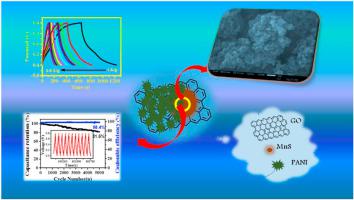Materials Today Chemistry ( IF 7.3 ) Pub Date : 2020-12-24 , DOI: 10.1016/j.mtchem.2020.100394 K.Y. Yasoda , S. Kumar , M.S. Kumar , K. Ghosh , S.K. Batabyal

|
We demonstrate a high surface area of manganese sulfide (MnS) nanoparticles via a simple solution method and investigated its morphology, physicochemical, and electrochemical studies. For the first time, we attempted to exploit the polymerization of aniline without adding HCl, as it is corrosive to the metal sulfide. Instead, the acidic group present on the graphene oxide surface plays a significant role to some extent as an acidic dopant in the polymerization process. This in-situ polymerization results in the uniform coverage of granular PANI on the entire MnS/GO nanocomposite, which enhances the interfacial interactions between PANI and MnS/GO nanoparticles. The introduction of graphene oxide (GO) to pristine MnS improved the specific capacitance, surface area, and average pore size. And incorporating PANI to MnS/GO leads to an increase in the interfacial interaction between the different pore sized nanoparticles giving enhanced specific capacitance. The specific capacitance for MnS/GO/PANI nanocomposite as measured by galvanostatic charge-discharge measurements was found to be 773 F/g at 1 A/g current density, and even at higher current density, it showed a specific capacitance of 484 F/g at 3.8 A/g. The specific capacitance obtained for MnS/GO/PANI nanocomposite from CV shows 822 F/g at 10 mV/s and 315 F/g at 200 mV/s. The combinatorial effects without destroying the metal sulfide nanostructure can provide an alternate route to design, promising electroactive nanocomposites is an ideal choice as a cost-effective, next-generation high-performance supercapacitor application.
中文翻译:

在用于超级电容器的高导电石墨电极上制备MnS / GO / PANI纳米复合材料
我们通过简单的溶液方法展示了高表面积的硫化锰(MnS)纳米颗粒,并对其形态,物理化学和电化学研究进行了研究。我们首次尝试在不添加HCl的情况下开发苯胺的聚合反应,因为它对金属硫化物具有腐蚀性。相反,存在于氧化石墨烯表面上的酸性基团在聚合过程中在某种程度上起着酸性掺杂剂的作用。此原位聚合导致颗粒状PANI在整个MnS / GO纳米复合材料上均匀覆盖,从而增强了PANI与MnS / GO纳米粒子之间的界面相互作用。在原始MnS中引入氧化石墨烯(GO)可以改善比电容,表面积和平均孔径。将PANI掺入MnS / GO会导致不同孔径纳米粒子之间的界面相互作用增加,从而提高比电容。通过恒电流充放电测量测得的MnS / GO / PANI纳米复合材料的比电容在1 A / g电流密度下为773 F / g,甚至在更高电流密度下也显示出484 F / g的比电容。 g在3.8 A / g。从CV获得的MnS / GO / PANI纳米复合材料的比电容在10 mV / s时显示为822 F / g,在200 mV / s时显示为315 F / g。



























 京公网安备 11010802027423号
京公网安备 11010802027423号